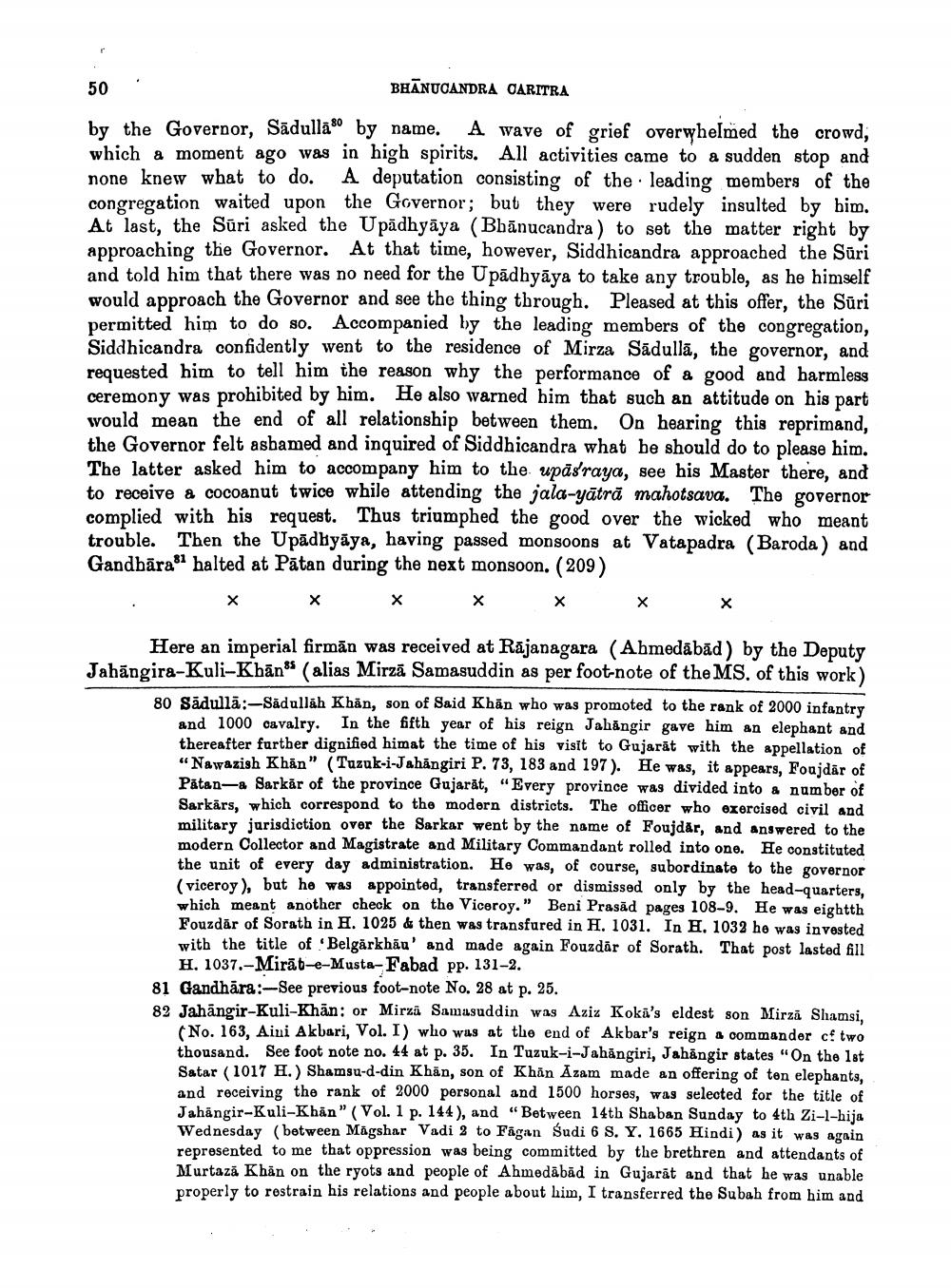________________
50
.
BHĀNUCANDRA CARITRA
by the Governor, Sādullāso by name. A wave of grief overwhelmed the crowd, which a moment ago was in high spirits. All activities came to a sudden stop and none knew what to do. A deputation consisting of the leading members of the congregation waited upon the Governor; but they were rudely insulted by him. At last, the Sūri asked the Upadhyāya (Bbānucandra ) to set the matter right by approaching the Governor. At that time, however, Siddhicandra approached the Sūri and told him that there was no need for the Upādhyāya to take any trouble, as he himself would approach the Governor and see the thing through. Pleased at this offer, the Sūri permitted him to do so. Accompanied by the leading members of the congregation, Siddhicandra confidently went to the residence of Mirza Sādullā, the governor, and requested him to tell him the reason why the performance of a good and harmless ceremony was prohibited by him. He also warned him that such an attitude on his part would mean the end of all relationship between them. On hearing this reprimand, the Governor felt ashamed and inquired of Siddhicandra what he should do to please him. The latter asked him to accompany him to the upăsraya, see his Master there, and to receive a cocoanut twice while attending the jala-yātrā mahotsava. The governor complied with his request. Thus triumphed the good over the wicked who meant trouble. Then the Upādbyāya, having passed monsoons at Vatapadra (Baroda) and Gandbāras halted at Patan during the next monsoon. (209)
Here an imperial firmān was received at Rājanagara (Abmedābād) by the Deputy Jahāngira-Kuli-Kbāns (alias Mirzā Samasuddin as per foot-note of the MS. of this work)
80 Sadullā:-Sadullah Khan, son of Said Khān who was promoted to the rank of 2000 infantry
and 1000 cavalry. In the fifth year of his reign Jahangir gave him an elephant and thereafter further dignified himat the time of his visit to Gujarat with the appellation of “Nawazish Khân" (Tuzuk-i-Jahangiri P. 73, 183 and 197). He was, it appears, Foajdär of Påtan- Sarkår of the province Gujarāt, "Every province was divided into a number of Sarkars, which correspond to the modern districts. The officer who oxercised civil and military jurisdiction over the Sarkar went by the name of Foujdar, and answered to the modern Collector and Magistrate and Military Commandant rolled into one. He constituted the unit of every day administration. He was, of course, subordinate to the governor (viceroy), but he was appointed, transferred or dismissed only by the head-quarters, which meant another check on the Viceroy." Beni Prasad pages 108-9. He was eightth Fouzdär of Sorath in H. 1025 & then was transfured in H. 1031. In H, 1032 he was invested with the title of Belgårkhäu' and made again Fouzdär of Sorath. That post lasted fill
H, 1037.-Mirāb-e-Musta-Fabad pp. 131-2. 81 Gandhāra: -See previous foot-note No. 28 at p. 25. 82 Jahāngir-Kuli-Khan: or Mirzā Samasuddin was Aziz Koka's eldest son Mirzā Shamsi,
(No. 163, Aini Akbari, Vol. I) who was at the end of Akbar's reign a commander of two thousand. See foot note no. 44 at p. 35. In Tuzuk-i-Jahangiri, Jahångir states "On the 1st Satar ( 1017 H.) Shamsu-d-din Khän, son of Khan Azam made an offering of ten elephants. and receiving the rank of 2000 personal and 1500 horses, was selected for the title of Jahangir-Kuli-Khan" (Vol. 1 p. 144), and “Between 14th Shaban Sunday to 4th Zi-1-hija Wednesday (between Mägshar Vadi 3 to Fägan Sudi 6 S. Y. 1665 Hindi) as it was again represented to me that oppression was being committed by the brethren and attendants of Murtază Khan on the ryots and people of Ahmedābād in Gujarat and that he was unable properly to restrain his relations and people about him, I transferred the Subah from him and




